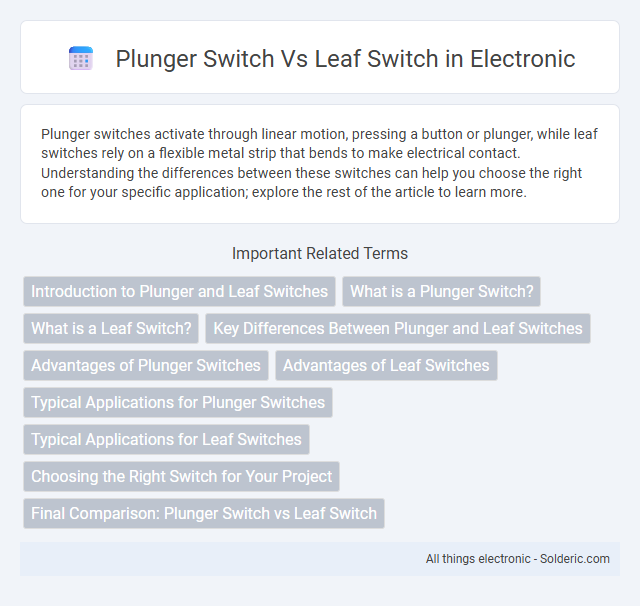Plunger switches activate through linear motion, pressing a button or plunger, while leaf switches rely on a flexible metal strip that bends to make electrical contact. Understanding the differences between these switches can help you choose the right one for your specific application; explore the rest of the article to learn more.
Comparison Table
| Feature | Plunger Switch | Leaf Switch |
|---|---|---|
| Type | Mechanical push-button switch | Flexible spring contact switch |
| Operation | Activated by direct linear press on the plunger | Triggered by bending or deflecting a thin metal leaf |
| Contact Style | Normally open or closed with fixed plunger | Normally open with movable leaf contact |
| Durability | Moderate lifespan, prone to wear with frequent use | Higher durability due to flexible contact mechanism |
| Applications | Used in push-button control panels, machinery stop/start | Common in limit switches, sensors, and precision control |
| Size & Design | Bulkier, requires space for plunger movement | Compact and suitable for tight spaces |
| Sensitivity | Lower sensitivity, requires deliberate press | Higher sensitivity, responds to slight deflections |
| Cost | Generally lower cost | Typically higher cost due to precision parts |
Introduction to Plunger and Leaf Switches
Plunger switches are mechanical devices activated by linear motion, commonly used for precise position detection in industrial machinery. Leaf switches feature a flexible metal strip that bends under pressure to complete an electrical circuit, ideal for simple on/off control in consumer electronics. Both switches serve as crucial components in control systems, with plunger switches favored for durability and leaf switches valued for sensitivity.
What is a Plunger Switch?
A plunger switch is a mechanical device that activates or deactivates an electrical circuit when a movable plunger is pressed or released, commonly used in appliances and machinery for precise control. Unlike a leaf switch that employs a flexible metal leaf to complete the circuit, the plunger switch relies on direct physical pressure to trigger its contacts. Understanding your plunger switch helps in identifying its suitability in applications requiring robust and reliable actuation.
What is a Leaf Switch?
A leaf switch is a type of mechanical switch characterized by a flexible metal strip that moves to open or close an electrical circuit when pressure is applied. Unlike a plunger switch, which operates through a pressing button, a leaf switch relies on the bending of its thin metal leaf to trigger the electrical connection. Your choice between the two depends on the specific application requirements for sensitivity and durability in electronic devices.
Key Differences Between Plunger and Leaf Switches
Plunger switches operate through a mechanical button that moves a plunger to open or close an electrical circuit, offering precise tactile feedback and reliable durability in industrial applications. In contrast, leaf switches use a flexible metal strip that bends to make or break contact, allowing for quicker response times and suitability in compact or delicate electronic devices. Key differences include the mechanical action (plunger's linear movement versus leaf's bending contact), typical use cases, and varying sensitivity levels tailored to specific operational requirements.
Advantages of Plunger Switches
Plunger switches offer precise mechanical actuation with high durability, making them ideal for environments requiring reliable on/off control under frequent use. Their compact design allows easy integration into limited spaces, enhancing operational efficiency in various industrial and consumer applications. The robust construction of plunger switches provides resistance to dust and moisture, ensuring long-term performance even in harsh conditions.
Advantages of Leaf Switches
Leaf switches offer superior durability and reliability compared to plunger switches due to their simple, non-contact design that reduces wear and maintenance requirements. Their faster response time and higher sensitivity make them ideal for precise applications in industrial automation and control systems. The low actuation force and long operational life contribute to enhanced performance in environments requiring frequent or rapid switching.
Typical Applications for Plunger Switches
Plunger switches are commonly used in industrial machinery for precise position detection and limit control due to their robust mechanical design. Typical applications include elevator door controls, conveyor belt monitoring, and safety interlocks in manufacturing equipment. Your systems benefit from their reliability in harsh environments where consistent actuation is critical.
Typical Applications for Leaf Switches
Leaf switches are commonly used in industrial machinery, home appliances, and automotive systems due to their reliable low-force operation and durability. These switches are ideal for detecting movement, position, or as limit switches in automated equipment and conveyor belts. Your choice of a leaf switch can enhance precision and efficiency in control mechanisms requiring quick, consistent actuation.
Choosing the Right Switch for Your Project
Selecting the right switch for your project depends on application requirements such as mechanical durability, actuation force, and environmental exposure. Plunger switches excel in precise, high-force actuation with robust metal plungers suitable for industrial equipment, while leaf switches offer flexible, low-force activation ideal for lightweight or delicate mechanisms in consumer electronics. Evaluating factors like expected switch lifespan, response sensitivity, and mounting constraints ensures optimal performance and reliability tailored to your specific use case.
Final Comparison: Plunger Switch vs Leaf Switch
Plunger switches offer precise actuation with a linear motion ideal for applications requiring accurate position detection, while leaf switches provide a simpler, cost-effective design with rapid response suitable for low-force toggling. The durability of plunger switches is often higher in heavy-duty environments, whereas leaf switches excel in compact spaces with limited mechanical stress. Choosing between them depends on the specific operational requirements, including sensitivity, range of motion, and environmental conditions.
plunger switch vs leaf switch Infographic

 solderic.com
solderic.com